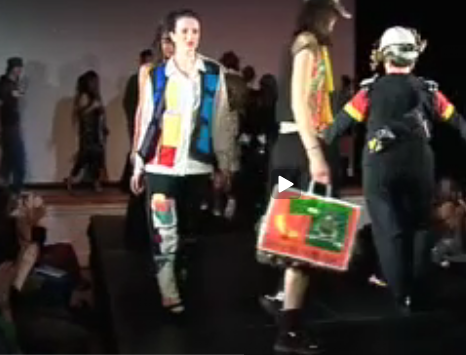Military clothing has long been adopted into civilian wardrobes. And military styling is all the rage with high fashion designers, advertisers, and clothing chains.
Women of Color Resource Center (WCRC) created “Fashion Resistance to Militarism”,
a provocative exposť of how militarism has seeped into our homes, our
closets, and our minds. The first show was a one-night, standing
room only event in Oakland on May 31, 2005, using fashion to explore a
serious, intense, and sometimes very controversial topic in a creative
way.

See Sample Fashion Show Video1 and Video 2
Models wore outfits created by local fashion designers,
seamstresses, thrift store queens, as well as everyday street camo and
demo wear. Writer and professor Cynthia Enloe explained the military origins of khaki. Spoken word artists and musicians added to the excitement—and the political analysis.
Each design was paired with an informative script. Together the outfits told a wider story about militarism and “counter couture” for peace and justice, as described in Why War Is All the Rage.
WCRC also produced a10-minute documentary that
shows how militarized our society has become. The 2-cd “Runway Peace
Project “ includes this documentary + how to create your own fashion
show, available here. A set of postcards featuring 7 models and outfits are available here. Each includes a caption that summarizes the script read by the narrator at the show.
Since then, Fashion Resistance to Militarism has been produced in several cities across the country by various organizations, including in Atlanta, Claremont, Detroit, Eugene, Oakland, San Diego, San Francisco, Syracuse, Washington, DC, and the heavily militarized Pacific island of Guam.
Each show is unique. Some have focused on
militarism and gender. Others feature outfits about federal tax
dollars spent on militarism and war, or environmental contamination
caused by war and military training. Many have included peace
activists who take to the catwalk in demo wear.
The WCRC show (2005) and the Eugene show (2010)
were full blown theatrical events, with a “runway,” stage lights, slide
show, and sound track. They included local fashion designers and
artists, spoken word artists, musicians, and other performers.
Other shows have offered a smaller taste – 5 or 6 outfits + scripts –
as part of a workshop or conference.
Christine
Ahn and Gwyn Kirk write about how “this unlikely genre is a highly
effective way to discuss the militarization of culture in accessible
terms and to get the audience thinking about heavy topics like the
military budget or sexualized military violence.” Read full story www.commondreams.org/view/2009/03/10-5
CREATE YOUR OWN FASHION SHOW
Women for Genuine Security is the institutional home for Fashion
Resistance to Militarism. We encourage students and community
groups to create your own show using sample
scripts and designs archived here as a starting point. At a
minimum you’ll need models, outfits, and a narrator to read the
scripts. Beyond that, your imagination can take off! Send a link
or photos of your show to info [at] genuinesecurity.org to be
added to this growing archive.
But much of the excitement of producing a show is in
designing your own outfits that are relevant to your community and that
tell the story you want to tell. This is a great way to involve
local artists and designers, art students, yard-sale and thrift-store
bargain hunters, and anyone who is handy with a needle, a stapler, or
duct tape. Local peace groups may also want to co-sponsor and bring
information to your event.
For all the talk of change, militarism hasn't gone
away under the Obama administration—far from it. The militarization of
everyday life is in the air we breathe and the ideas we accept.
"Fashion Resistance to Militarism" is one popular way to break the
militarized mentality that is more pervasive than any war , and to
expose how militarism creeps into our national budgets, foreign
policies, interpersonal relationships, and, yes, fashion.
|




